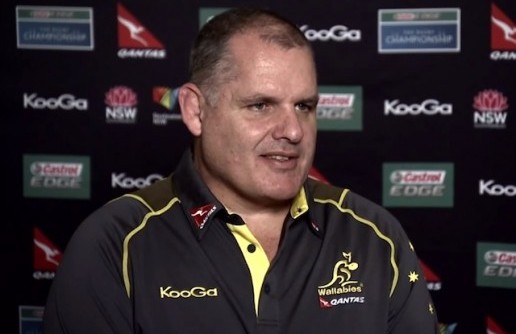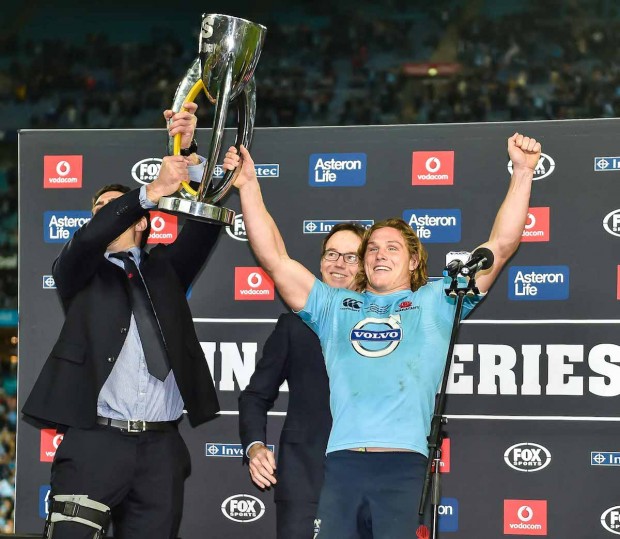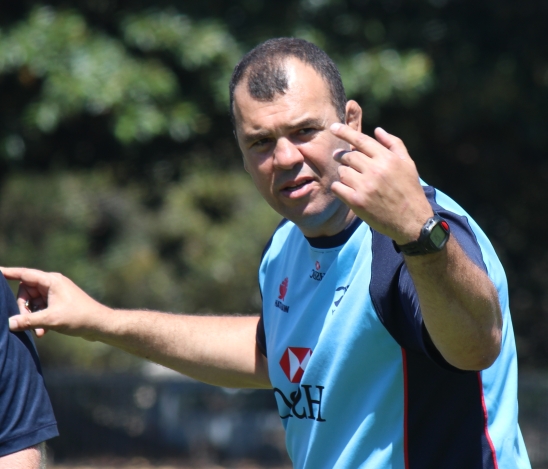Last Saturday night was such a mixture of relief and euphoria that its taken a while to reflect on the underlying nature of the contest. With five minutes to go, I was glued to my seat wondering how on earth the team that had dominated the game was two points behind and looking like losing again. Then the glory of the final penalty and the celebration of the win drove those thoughts to the back of my mind.
Apart from the kicks to exploit Nadolo’s weaknesses, the Waratahs ran the ball at the Crusaders unwaveringly the whole game. Two points down with five minutes to go, Crusaders with their tails up, what the Waratahs did was what they had trained to do all year. For four minutes the current team ran and ran and ran at the Crusaders till at last they found a chink and forced a penalty. This is the most important characteristic that Cheika has instilled into the 2014 team – he insists that the team plays the Waratah game right up until the fat lady sings. It was not always so.
2005, The First Shot: The Crusaders met the Waratahs in the final in Christchurch. It was McKenzie’s first major final as head coach, but when the players were lined up on paper they were remarkably even, with the only real mismatch between Carter and McKay at 10. Both teams had gone through the season at 9 and 2, with the Crusaders accruing more bonus points. In the lead up to the game McKenzie made no secret of the fact that the Waratahs were going to play a composite field position/running game so that the Crusaders would not be able to predict what was coming at them. Only in the last quarter, when the game was gone, did they really unleash the running game, alas too late. But the overwhelming impression was that the Waratahs had “bottled it” against a very good Crusaders team, who were not going to be beaten with a standard conservative game.
2008, The Second Shot: Again the Waratahs met the Crusaders in Christchurch, after the Crusaders were two games and three bonus points clear at the end of the 14 rounds. The Waratahs now had Beale at 10 in his first season and many of the players from three years before. The game see-sawed, with Beale in the second half starting to take the game by the throat until he was badly injured and replaced by Norton-Knight. The Waratahs scored two tries to one and were undone by the kicking boot of Dan Carter. They played sharp attacking football until Beale’s injury, but the Crusaders soaked up the pressure and kicked away. Still the game was considerably closer than 2005 and the Waratahs arguably played the better football.
2011, Link’s best shot: Now with the Reds after being shafted by the NSW back office, McKenzie coached the Reds to a grand final against the Crusaders in Brisbane and duly won it through scintillating backline running. But the season had been notable for the success of McKenzie’s use of variable gameplans; notably against the Stormers in Cape Town. The Reds basically used the Stormers usual gameplan against them, with resounding success. McKenzie had become a coaching chameleon, with his teams adopting gameplans tailored to the strengths and weaknesses of the opposition
2014, Cheika’s first: Cheika had taken the coaching role in 2013 after a disastrous 2012 under Michael Foley. From the first game he insisted that the team would run the ball and be much more forward-physical and fitter than previous teams. In 2013, after an uneven year with very mixed performances week-to-week, the team finished mid-table. But they were playing a very different style to other teams and when they were on they were great to watch. The crowds began to slowly dribble back from a very low base. In the first half of the 2014 competition they were winning and losing in alternate weeks but they were starting to look like they could be a great team if they could gain some consistency. The turning point came in a game against the Hurricanes, the most adventurous team in the comp. Down 22-7 after 20 mins they clawed their way back to parity by half time and went on to win by playing their version of ball-in-hand rugby. They didn’t lose another game and played great-to-watch football right up to the final where they won in the last two minutes after dominating most of the game.
What the two coaches have in common: Both coaches come from the Randwick club in Sydney, the home of the “running game”. Both coaches were forwards, who also understood backline play. Both are undeniably “Australian” in their outlook, with “having a go” being part of their makeup. They are both honest with their players, don’t suffer fools gladly and don’t noticeably play favorites. (Some would say all coaches play favorites, some coaches choose the right favorites and others don’t.) They are aggressive, positive and attack minded. Just as it took time to change the game for the Reds and Waratahs, so it took time to redirect the Wallabies energies after the poor Lions tour.
Where are the differences? Despite what they have in common, there are fundamental differences in their approach to coaching the game:
McKenzie has a concentration on the set-piece with his forwards, as well as a focus on the breakdown. He has a full-time forward set-piece coach and a full-time attack coach for the backs under his overall control. He likes to vary the team’s style of play depending on conditions and what he believes the other team will bring to the table. Hence the massive difference between the first and second tests against the French this year, where you would have thought the players in the two tests were entirely different players. Fundamentally the opposing coach does not know how the McKenzie team will play until it is revealed on the park.
Cheika concentrates on the breakdown area and the attacking mindset and physicality of his team. His assistant coaches are a defence coach and an attack coach. Set-piece is coached by part-time coaches, the scrum reportedly by Benn Robinson. The Cheika way is a very pure version of the “Randwick” game. But the clearest difference is that Cheika seeks to impose his style on the game and if the other team are good enough to win he will still have the team come out and play that plan next week, just trying to do it better. Fundamentally, the opposing coach knows what’s coming, there are only minor changes in the detail; the hard part is actually responding to it because the “Randwick” game is hard to play but very difficult to neutralise if it is played well.
The difference is that one coaches as a pragmatist and one as an an idealist. Now most rugby coaches tend to the pragmatic; of the current Super Rugby coaches perhaps Coetzee, White, Foley, Cheika and Joseph might be classed as predominantly idealistic, only Joseph and Cheika would be classed as attackingly idealistic. Both coaches are good motivators but Cheika is an attacking idealist, whilst Mckenzie is an attacking pragmatist. What is clear is that the Wallabies will not immediately morph into a copy of the Waratahs.
The first Bledisloe test next Saturday will be between two coaches who are both pragmatists and both with an attacking mindset, though Hanson is more of a counterpuncher than an out-and-out attacker. So the gameplans will be the sum of what the coaches think the other team will do; what their strengths and weaknesses are and how their own teams can take advantage. Who they select for particular positions will be informed by the chosen gameplan.
If the Wallaby team is selected as has been reported they are training, then the make-up will not be Waratah-dominated as might have been expected from the season results. Instead, McKenzie will look for players who can best vary their play according to requirements. On that basis, I expect that White will be chosen over Phipps, that Beale will be on the bench, AAC will be shunted to the wing again and that McCabe will edge out Horne. If you were selecting the team with a Cheika-like idealism then no doubt the team would look different.
Regardless of selections, I hope the Wallaby coaches are starting the planning for the game on the basis of imposing our game on the NZ team; we need to put them out of their comfort zone and keep them there as the Waratahs did in the final. Australians play rugby best when they are running at the opposition, imposing ourselves on the game, not waiting for it to happen to us. This must be the starting point for everything we plan to do.
We will find out on Thursday who is in the team but we will have to wait for Saturday to find out whether Australia will be Bledisloe-competitive this year. With the second test at Eden Park, the Sydney test is a must-win game. You would think the Bledisloe and the Rugby Championship are gone for the year if the Wallabies lose in Sydney, so just like last Saturday, everything’s on the line. Here’s to a massive double at Olympic Stadium!




